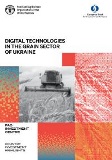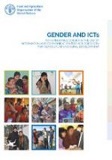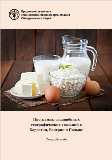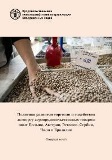
Europe and Central Asia – Regional Overview of Food Security and Nutrition 2023
Publication Series
Publications

Digital technologies in the grain sector of Ukraine
02/2023
Comprising 30 percent of agricultural output and with an area of 15 million hectares, the grain sector is a pillar of Ukraine’s agriculture. In 2020 Ukraine exported USD 9.4 billion worth of cereals, the second largest exporter after the United States of America, making Ukraine a major contributor to global food security.
![cc1925en_200[1]](/images/reulibraries/default-album/cc1925en_200-1-.tmb-th600x450.jpg?Culture=en&sfvrsn=bdd69515_2)
Improving social protection for rural populations in Europe and Central Asia Priorities for FAO
09/2022
FAO’s Strategic Framework (2022–2031) envisages the transformation to more efficient, inclusive, resilient, and sustainable agrifood systems for better production, better nutrition, a better environment, and a better life, leaving no one behind. In this scope, FAO promotes inclusive economic growth by reducing inequalities between urban and rural areas, rich and poor countries, men and women to attain a better life for all.

Modernizing irrigation in Central Asia
11/2022
Modernizing irrigation systems in Central Asia could increase the productivity of the irrigation sector to meet growing food and export demand, while also improving farmers’ livelihoods.

ePHYTO solution - An innovative system for electronic phytosanitary certificates
02/2023
This good practice factsheet introduces the ePhyto Solution, an innovative system for issuing and exchanging phytosanitary certificates in electronic form in import and export of plants and plant products. The ePhyto Solution supports this objective by responding to the needs of the twenty-first century. Electronic certificates eliminate several drawbacks of paper certificates, such as damage or fraud, and the ePhyto Solution increases the efficiency of their exchange.

Yearbook 2021: Lifecycle Management of Pesticides and Disposal of POPs Pesticides in Central Asian countries and Türkiye
01/2022
Within the scope of this Yearbook 2021, the main achievements of the GEF funded/ FAO managed project 'Lifecycle Management of Pesticides and Disposal of POPs Pesticides in Central Asian countries and Turkey' in the last year are highlighted, in order to share progress with the key stakeholders and to increase the synergy for more efficient results ahead. Overall information as well as country based information can be found in the Yearbook 2021.

FAO in Europe and Central Asia 2021
01/2022
FAO’s work in Europe and Central Asia and throughout the world is guided by the FAO Strategic Framework, reviewed every four years. In its support for the 2030 Agenda and its drive for a transformation to more efficient, inclusive, resilient and sustainable agrifood systems, the new FAO Strategic Framework 2022–2031 focuses on what are called the four betters – a set of goals that, when implemented, will help ensure that no one is left behind.

Mainstreaming gender in the use of information and communication technologies (ICTs) for agriculture and rural development
02/2018
Women, who face a triple divide: digital, rural and gender. This publication looks at the benefits of Information and Communication Technologies (ICTs) when placed in the hands of men and women working in agriculture and in rural areas. It examines the challenges to be overcome and makes recommendations so that rural communities can take full and equal advantage of the technologies. 2018, 87 p.

Status of Digital Agriculture in 18 countries of Europe and Central Asia
09/2019
ICTs have been clearly observed to play an emerging role in Europe and Central Asia, acting as an engine for agricultural development, especially as demand grows for reliable and readily accessible information at all levels of the industry. The state of the digital agriculture ecosystem differs from country to country, and from region to region in individual countries. 2020, 102 p.
![cc2041en_200[1]](/images/reulibraries/default-album/cc2041en_200-1-.tmb-th600x450.jpg?Culture=en&sfvrsn=b4cd878d_1)
National gender profile of agriculture and rural livelihoods - The Republic of Azerbaijan
07/2022
This country gender assessment (CGA) for the Republic of Azerbaijan was undertaken as part of FAO and national commitments to promote gender equality while integrating a gender perspective into its operations. The resulting CGA report focuses on the intersections of gender, agriculture and rural development, and presents a snapshot of critical gender-based inequalities and their consequences for agricultural production and rural livelihoods in Azerbaijan.

Assessment of Agribusiness Environment in Kyrgyzstan: Summary of Value Chain Gap Analysis and Recommendations
01/2018
John O’Connell, Pavel Kiparisov. The paper examines existing support measures for agriculture and covers the banking sector and trade policy. In addition, the paper describes main value chain actors and international development programmes.

Ukraine’s agricultural sector after accession to the WTO
01/2015
Kobuta Iryna, Vitaliy Zhygadlo, Aleksandr Sikachyna. This country study is a part of the FAO series of case studies on assessing the impact of the WTO accession on agriculture in countries of the region.

Globally Important Agricultural Heritage Systems (GIAHS). Combining agricultural biodiversity, resilient ecosystems, traditional farming practices and cultural identity
04/2018
For centuries, farmers, herders, fishers and foresters have developed diverse and locally adapted agricultural systems managed with time tested, ingenious techniques. These practices have resulted in a vital combination of social, cultural, ecological and economic services to humankind. “Globally Important Agricultural Heritage Systems” (GIAHS) are outstanding landscapes of aesthetic beauty that combine agricultural biodiversity, resilient ecosystems and a valuable cultural heritage.

Review of Agrifood Trade Policies in the Post-Soviet Countries 2015-2016: Summary
01/2017
The main economic and political factors influencing the patterns of agrifood trade in the region during 2014 generally continued to have an impact in 2015 and 2016.

Review of Agricultural Trade Policies in the post-Soviet Countries, 2016-2017 - Summary
01/2018
This is the third review in the series on agricultural trade and trade policies in the post-Soviet region prepared within the framework of the Food and Agriculture Organization of the United Nations’ (FAO) Regional Initiative on Improving Agrifood Trade and Market Integration in Europe and Central Asia.

National programs and strategies in support of agri-food exports in the post-Soviet countries (available in Russian)
01/2018
Данный обзор посвящен различным аспектам политики постсоветских стран в области поддержки экспорта агропродовольственной продукции.

Review of agricultural trade policies in post-Soviet countries 2017–2018
01/2020
The publication presents analysis of agricultural trade policies in post-Soviet countries. The aim of the review is to monitor the latest changes in trade policies of these countries, affecting the dynamics and structure of trade.

Countries in the Commonwealth of Independent States: Agricultural policy issues in the context of the World Trade Organization
01/2014
Lars Brink. With the disintegration of the Soviet Union 15 new countries entered the world stage. This report examines the experience and main issues of twelve of these countries in the context of the rules and commitments in agriculture under the World Trade Organization (WTO).

Wheat production and regional food security in CIS: The case of Belarus, Turkmenistan, and Uzbekistan
04/2016
Zvi Lerman, David Sedik, Yuliy Yusupov, Ivan Stanchin and Irina Kazakevich. Belarus, Turkmenistan and Uzbekistan are not significant regional grain traders. [...] However, production of wheat in the three countries has risen dramatically since 1992. This rise in production has been accomplished through huge increases in area, as well as (for Uzbekistan) significant increases in yields.

Geographical indication schemes in Croatia, Hungary and Poland
01/2018
General rules concerning geographical indications (for food products) are the same in all European Union countries. In light of this, the aim of the report is not to focus on the solutions of the community; rather, the report attempts to answer the question of how and for what purpose European quality policy tools are used in these countries.

Agrifood marketing and export promotion policies: case studies of Austria, Brazil, Chile, Estonia, Poland and Serbia
01/2019
The purpose of this paper is to identify the best promotional practices implemented in different countries and share them with governments planning to adopt or review trade promotion policies and with stakeholders.
